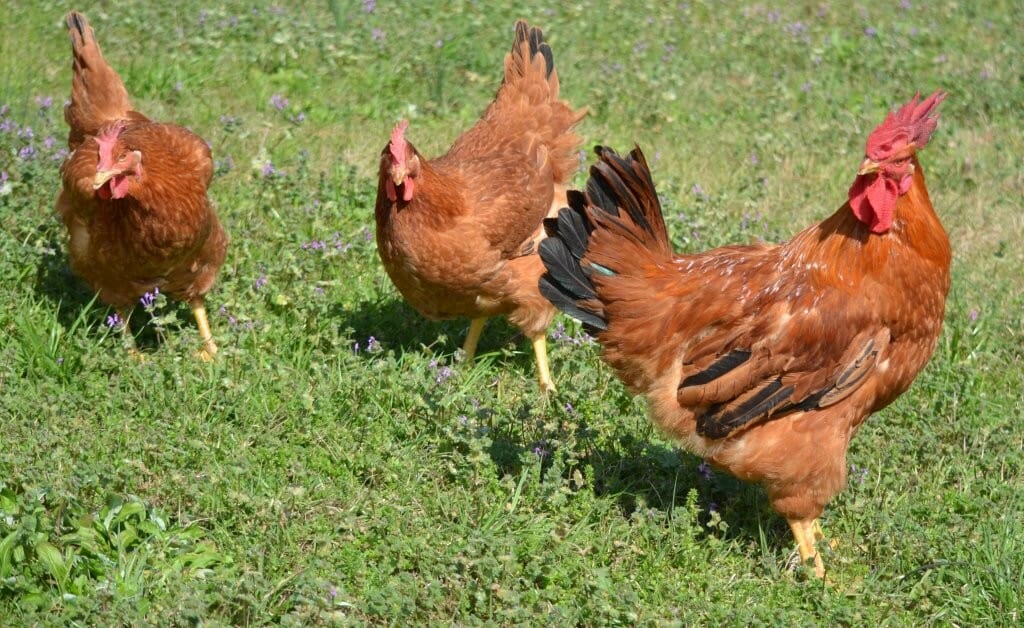For most homesteaders and those working toward a more sustainable lifestyle, raising meat animals is almost a rite of passage. Due to the ease of raising and harvesting poultry, chickens are generally the first animal most of us turn to when starting our journey into raising our own meat.
The first step to home chicken production success is determining what type of chickens you want to raise. Any chicken can be grown for meat, although certain breeds produce a far better yield than others. Birds grown for table use primarily will fall into one of four categories:
Traditional Broilers
Of the broiler class, the white Cornish Cross is the most common. These birds grow the quickest and produce the most meat. By far, they are the most economical of the meat birds to raise as they have a superior feed-to-meat ratio. These birds are not known to pasture well and do best being reared on commercial feeds.
Cornish Cross are generally ready to butcher by 6-8 weeks, but are often plagued by joint and heart issues due to the speed at which they grow. For best success with these birds, try using the 12/12 method of feeding (12 hours of available feed, 12 hours of no feed), and make sure to keep their water at the opposite end of their pen to encourage movement.
These Solar Backup Generators Deliver 4 Times More Power Than Other Models!
Traditional Broilers are generally a crossbreed and do not breed true, so if you raise these birds you will need to purchase chicks each time.
Pasture Broilers
As pastured meat has become more popular, so has the breeds which take up this niche. These birds have been bred to have not only good feed conversion on commercial feeds, but also excellent conversion of pasture-based diets. The more common breeds in this category are the Red Ranger, Freedom Ranger, Pioneer, and both the Black and Red Broiler.
Though not as quick-growing as the Traditional Broilers, these birds often finish at 9-11 weeks. Pasture Broilers are often not plagued with the health problems of the Traditional Broilers and are naturally mating, which make them a good choice if you plan to rear your own chicks down the road.
Dual Purpose
Dual-purpose birds are large and meaty, although the hens are also excellent layers and often good mothers. Quite a few of the typical farm favorites fall into this category, including the Rhode Island Red, New Hampshire, all varieties of Wyandotte, Plymouth Rocks and Orpingtons, just to name a few.
This category of meat bird is the easiest to find and generally lend themselves well to both pasture rearing and commercial feed rearing. However, dual-purpose breeds are one the slowest to grow, and may be 14-16 weeks old before reaching a good size and meatiness.
Like Pasture Broilers, the Dual Purpose breeds will mate naturally and hens will even go broody and hatch their own chicks.
Giants
In recent years the Jersey Giant and the larger varieties of Cochin and Brahma have become popular for backyard meat breeders. In addition to taking a lot of space, they tend to have one of the poorest feed conversion ratios. Breeders claim that the meat is superior to many others in terms of flavor, though, so if you are willing to wait the 16-24 weeks from hatch to harvest, this may be a choice for you.
Caring for Your Meat Chicks
Like any chicken, starting meat birds off correctly requires good brooding space that is protected from the elements and predators alike. Remember that in the first week they will need temperatures of around 95 degrees, but you can lower the temperature by as much as 5 degrees each week until they are off heat. Chicks also will need a constant supply of clean water and a quality chick starter.
Feeding Your Birds
Feeding your birds will largely depend on what category they fall in and how you choose to raise them. For quickest results a diet of commercial feed is the easiest to follow, with birds being fed a Chick Start (22 percent protein) for the first few weeks, moving to a Meat Grower feed (20 percent protein), and using a Finisher feed (18 percent percent) for the last two weeks before harvest. Birds are usually allowed feed at all times, although it is advised to keep water at the opposite end of their pens to encourage the birds to get up and move.
Diatomaceous Earth: The Best All-Natural De-Wormer For Your Livestock!
For those who decide to pasture raise with supplement feed, chicks can be acclimated to outside weather once they begin feathering at about a month of age. Keep in mind that they will still need shelter and secure fencing such as a large run or mobile chicken tractor. The feeding recommendations are still the same, though most pasture growers offer feed in the late afternoon or evening and remove it in the morning using the 12/12 method (12 hours of available feed, 12 hours off). This encourages the birds to forage or graze during the bulk of the day, cutting feed costs.
If it is available, it is possible to exclusively pasture poultry once they have transitioned from the chick starter to pasture. Keep in mind that growth rates will vary substantially based on the quality and quantity of available forage.
Raising your own chickens for meat is a very rewarding endeavor if you start off right and do your research before bringing home your birds. There is a sense of peace and accomplishment in knowing that you raised your meat with quality feed, care and respect to nourish not only yourself but your family.
What is your favorite meat chicken?
 Off The Grid News Better Ideas For Off The Grid Living
Off The Grid News Better Ideas For Off The Grid Living




